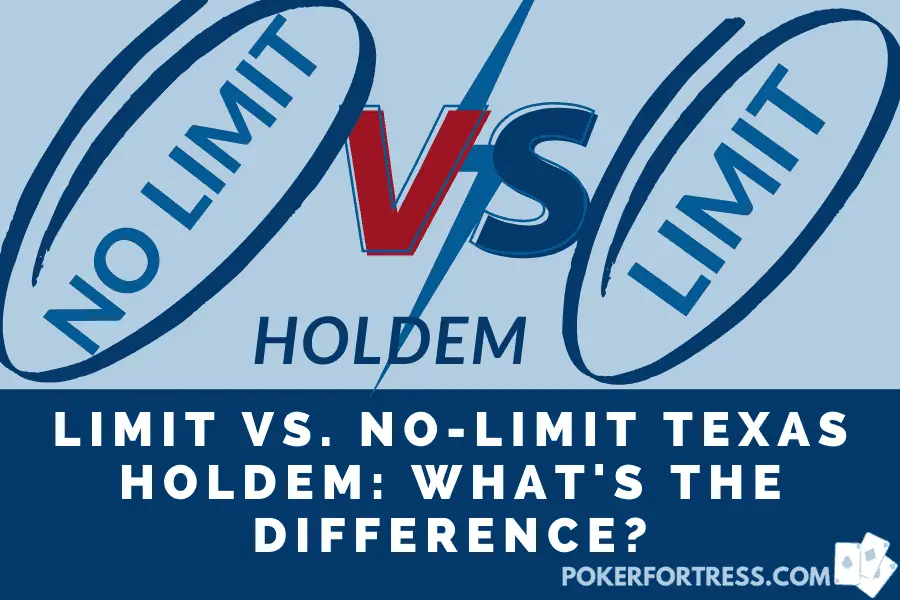Many new poker players start out playing no-limit Texas Hold’em. Only a while ago, limit Holdem was the more fashionable Texas Hold’em subgenre. These days, no-limit hold’em is the more popular choice even though there are still a lot of players who are enjoying considerable success playing limit and making nice money from it. Although there is less and less action in limit games, so you need to consider if it is worth learning limit Holdem for you. Whether you’re curious or looking to make the transition from no-limit to limit, this article will show you all you need to know about the two subgenres of Texas Hold’em and how they differ from each other.
Limit vs. no-limit texas holdem poker comparison:
| Limit Holdem | No-limit Holdem | |
| Popularity | Popularity going down | Extremely popular |
| Winrate | Small winrate (1BB is really good) | 10bb/100 is achievable |
| Softness of games | Soft | Intermediate |
| Chance of going pro | Unlikely | Possible |
| Fun | A bit boring and slow | Exciting and fun to play |
Let me explain the table above a bit. Limit Holdem used to be a very popular and preferred choice for the majority of players. But in the last 15 years, no-limit Holdem has surpassed it and now stands at the top of popularity in types of poker. And for a good reason.
It is not much fun playing limit Holdem and many players prefer putting in big bets and enjoy playing more when there is a lot of action going on the table. In no-limit Holdem you have a chance to go all-in every hand even before the flop if you so desire.
Ability to bet more chips also means that good players can have much higher winrates than in limit Holdem. In limit poker, you are lucky to achieve 1 big bet (2 big blinds) per 100 hands winrate, while in no-limit games you can consistently win at 10 big blinds or more. This is because many poker pros who used to play limit, have now moved to no-limit. But not all is grim for limit players, all these pros that left have caused limit games to be actually softer than they used to be.
Sadly, if you are looking to go pro, this information doesn’t help you much as it will be very hard to find many limit tables nowadays and you will struggle to put in enough grind hours to earn a solid income.

The significant difference between the two Texas Hold’em subgenres is that the best players save or make an extra big bet in limit hold’em, while in no-limit hold’em, the game is driven by implied odds. The most accurate analogy is that limit is like a carousel, while no-limit is like a rollercoaster. While some people prefer the comfy merry go round of limit, others are more excited by the thrill of going on full speed with no-limit.
No-limit and fixed limit are not the only variations of Texas hold’em. The third variation is called pot-limit, and its primary element is that bet sizes are limited by the size of the pot. Nowadays, Texas no-limit Holdem is by far more popular than other two variants of the game.
Before diving into the different facets of limit and no-limit hold’em, let’s get a little background information on Texas Hold’em just so we’re all on the same page.
Texas Hold’em
Texas Hold’em is one of the many variants of poker and is the most popular of them all. Like other poker variants, Texas Hold’em will test your mathematics, decision making, deception, and timing.
In Texas Hold’em, 7 cards are dealt in total. The first two cards are dealt pre-flop, and they are called the hole cards. The next five cards are called community cards, and they are dealt in three stages (flop, river, and turn). In the flop, three community cards are dealt face down while one community card each is dealt on the river and on the turn.

Each player aims to achieve the best 5 card combination from the 7 cards total. Players can raise, fold, call, or check. A player with the best hand who did not fold by the end of all betting rounds wins the bet money placed during the hand(the pot).
In Texas Hold’em, the objective of each player is to win the total bet money placed during a hand. Players have no control over the kind of cards they are dealt, hence, their aim is to control the pot based on the prediction of their opposition’s hand/ behavior or, on the strength of their own hands. An entire game is divided into hands, and each hand consists of a preflop, a flop, river, and turn. If at the end of each turn a winner has not emerged, the remaining players in the hand move to a final round called the showdown.
In the showdown, players get to compare their hands, and the player with the highest hand combination wins the pot. The aim of professional players in Texas Hold’em is not necessarily to win all the hands. It is to gather information in each hand to help them make logical and mathematically accurate decisions like how and when to place bets, call, fold, or raise. Each decision matters.
Those decisions are like a nonverbal representation of the kind of hand a player holds. During the course of the game, players get to read each other’s betting patterns and use the information gathered from previous betting hands to influence their decisions in subsequent hands.
Blinds and Table Position in Texas Hold’em
In Texas Hold’em, position refers to where you’re sitting on the table in relation to the dealer button. It has huge effect on how you will play your hand. Generally, you are more aggressive in position, and a bit more passive out of position.
The dealer button determines when it’s your turn to act depending on how close or further away you are from the button, you could be the first or last player to act in a hand. After a hand, the dealer button’s position is rotated in a clockwise direction to ensure every player gets the chance to enjoy the privileges that comes with being in a specific position during a hand.
There are two blinds in a game of Texas hold’em. They are the big blind and small blind. These blinds are forced bets placed in the pot by the first two players on the dealer’s left-hand side. The first player to the dealer’s left is the small blind while the next player is the big blind.

At the start of the first betting round (preflop), the first player to act in a hand is the player sitting on the left of the big blind. This player’s position is referred to as ”under the gun”. After preflop, the first player to act a hand in subsequent betting rounds is the player sitting in the position of the small blind( the first player to the right of the dealer button) while the player sitting on the dealer button’s position gets to act last.
Interested in winning more games in poker? Then this detailed article will let you know of the best books needed to achieve exactly that.
Betting Rules in Texas Hold’em
In Texas Hold’em, each player has the option to bet/raise, check/call, or fold. A player calls when he matches a previous bet while checking entails matching a prior non-bet. Chips are placed in the pot to make bets while raising involves betting an amount that is higher than the previous bet. Lastly, folding involves discarding your hand while you wait for the next hand.
Now that we know all about Texas Hold’em, let’s find out how its versions (limit and no-limit) differs from each other starting from the betting rules.
No Limit Betting Rules
No-limit Texas Hold’em is the variation for players who are excited by the game’s defining elements like luck, chance, skill, and action. There’s no doubting the rush of adrenaline that comes with placing all your chips in a pot during a hand. The excitement and unpredictability of no-limit Texas hold’em has been particularly appealing to many poker players, and this fact is visible in the increase in the number of no-limit participants in major events like the world series of poker.
The following are the acceptable betting patterns in no-limit Texas hold’em.
- Bet Size: The big blind’s betting amount is the minimum bet size that is permitted in a hand. Players can either match that amount by calling the blind or bet a higher amount by raising it. On the other hand, the maximum bet allowed is the player’s stack pile.
- Minimum Raise: The minimum raise allowed in no-limit Texas hold’em must match the previous raise or bet. That means if the first player raises preflop by $20, the next player who raises will need to at least match the previous raise plus the blind. Since the previous raise is $20 and the blind is $10, the next player who raises will have to raise by at least 30 dollars. A player can raise much higher if they wish. That is the beauty of no-limit hold’em, you can raise as much as your stack allows you.

Limit Betting Rules
Also called fixed-limit Texas hold’em, this hold’em version allows 2 bet sizes, and they are as follows.
- The first bet size is called the small bet, and it is allowed in preflop and on the flop.
- The second bet size is referred to as the big bet, and it is allowed on the turn and river.
The rules governing these bets are as follows
- Small Bet Size: The small bet size is the same amount as the big blind. This means that a $2/$4 fixed limit game will have $1/$2 blinds.
- Raise Limit: Unlike no-limit hold’em, players can only raise in relative to the previous bet. Also, only four bets are allowed in each rounds. This means if the first player raises preflop to $4, the next player who is willing to raise can only reraise to $6. The next player who raises can only raise to $8. This fourth bet is the limit and is called ”capping”. After the fourth bet, the other players left in a hand are no longer allowed to raise. They can only fold or call the previous raise.

The betting and raising on the next two rounds(turn/river) is doubled, which means if you’re playing $2/$4, the player who places the first bet can bet $4 while the next raiser will have to raise by $8.
Other Key Differences Between Limit & No-limit Hold’em
Apart from the betting rules, there are other key aspects of both versions of Texas Hold’em that differs and they are as follows.
Starting Hands
In fixed-limit hold’em, several unsuited big cards are correctly and regularly played as starting hands without much fuss. However, playing these starting hands in no-limit hold’em could be a recipe for disaster. For example, it is totally fine to play hands like KQ or AQ in fixed-limit hold’em, but most players avoid overplaying these hands or even fold them regularly with deep stacks in no-limit hold’em.
Manipulating Pot Odds
This is perhaps one of the most glaring differences between limit and no-limit hold’em. It is a common sight to watch players playing fixed-limit games complaining about how tight betting rules limit their ability to protect their hands. Although, this works both ways because these same tight betting rules allow players to turn over losing hands, which ensures they don’t have to lose all their stack. Yet, it is worthy of note that no-limit players have the freedom to protect the hand while limit players do not.

The Odds
Odds have their role in both limit and no-limit hold’em. However, implied odds holds more importance in no-limit hold’em because players are at liberty to place their entire stack as a one time bet. Although limit hold’em also features implied odds, it holds less importance because of the betting limits enforced. Therefore, while no-limit players can go all the way with a weak hand, fixed limit players are more concerned with pot odds and, as such, would not rely on implied odds to justify their decision to chase a draw. The structure of fixed-limit hold’em demands that players pay close attention to the odds if they hope to be successful.
Information
Although no-limit hold’em players are able to bet their entire stack, they are also aware that this kind of move could possibly give away their hand. More often than not, players who commit their entire stack are players with strong hands. Since placing a large bet gives away so much information on a player’s hand, many players in no-limit hold’em try to adhere strictly to their own bet sizing. Limit players don’t have to worry about revealing too much with their betting patterns because they can only raise within the betting limits.
Bluffing
In fixed-limit hold’em, many players believe bluffing is a poor choice with little chance of success. That said, it is not impossible to succeed with a perfectly timed bluff in limit hold’em, it is the success rate that worries most players. On the other hand, no-limit hold’em players are more likely to bluff because the chance of success is high enough. While this is an obvious advantage over the limit hold’em, it must be said that a failed bluff can cause more damage in no-limit hold’em since the betting sizes are not limited as in limit hold’em.
| FIXED LIMIT HOLD’EM | NO-LIMIT HOLD’EM |
| There is a betting limit | There is no betting limit |
| It’s easy to transit from limit to no-limit | It’s harder to transit from no-limit to limit |
| It’s difficult to defend your hand | It’s easier to defend your hand |
| Mathematical analysis crucial | Mathematical analysis not crucial |
| Impossible to lose all your stack in a single hand. | You can lose your entire stack in one hand if you go all in. |
Advantages of No limit Hold’em over Limit
With the information above, it is evident that several intricate details plays a role in the difference between both versions of Texas Hold’em. What can’t be disputed is the fact that players can amass great success in both versions, and that brings us to the next question, why do more players prefer no limit? Below are the perceived advantage of no-limit hold’em over limit hold’em.
Creative Control
One of the primary reasons more players prefer no-limit hold’em is the creative ability they retain while playing the game. No-limit hold’em doesn’t restrict bet sizes, which means you can bet as much as you want. With the limitless bet size allowed in no-limit, players are able to bluff regularly and effectively.
For example, a player with a strong hand in no-limit hold’em can overbet in the hope that his/her opponent will read the bet as a bluff. Also, an aggressive player who perceives his/her opponent has a weak range can re-raise all in one on the river as a bluff.
Unfortunately, these moves are practically impossible in fixed-limit hold’em because of the lack of creative control on bet sizes. Fixed limit’s 2 bet type rule places a restriction on a player’s ability to get creative with their bets. This limitation means players are less enthusiastic about bluffing. Hence, the flexibility and potential to win more with increased options available in no-limit ensures more players are choosing it over fixed-limit hold’em.
Less Pressure

If you’re a player who has got a grasp of hand match-ups and game theory, then fixed-limit hold’em doesn’t look as complicated as it seems for some players. A solid fixed limit player should be able to make excellent calculations based on the perceived range of his opponent and his hand. This gives him enough information to make decisions (call, bet, and fold) that are mathematically accurate during a hand.
A player who isn’t able to work out his math will find it challenging to win hands. It gets even worse if the player is playing against a skilled opponent. Coupled with the betting limit, the player who hasn’t worked out his/her maths will mainly depend on luck to win a hand in fixed limit poker. This is unlike no-limit hold’em where an amateur player can still get to win a hand regardless of his/her skill-set. In no-limit, a player can essentially go all-in on his/her opponents, forcing them to fold their better hands. In that case, you don’t necessarily have to be the player with the best strategy to win a hand. This is not to say just anyone can win hands in no-limit, it simply means that even the weakest player on the table has a chance. Simply put, there is more pressure to learn the mathematical side of Texas Hold’em in limit than in no-limit.
More Profits
Lastly, another reason why no-limit gets all the attention is that the pot in no-limit hold’em can reach huge proportions during a hand. Be it a tournament or cash game, the cash in the middle isn’t as significant when everyone on the table can bet all their stack at once whenever they deem fit.
This is in stark contrast to limit hold’em where the pot level is nowhere near the size of the blind. Obviously, it isn’t impossible to claim the money in the middle while playing fixed limit, but that would take many bets and raises, which could encourage opponents who sense that they’re behind to fold their hands.
Although the pot size should determine the amount of money players bet, the flexible nature of no-limit hold’em ensures that the money in the middle trumps the blind level by a large amount. It gets even crazier when you add over betting, which just makes the game a whole lot exciting. Winning poker players can make a lot of money in no-limit hold’em because the betting structure allows them to lure weak players into making huge bets, which just makes their profits higher.
It is also important to note that the betting structure in limit hold’em means limit tournaments takes longer than a normal no-limit tournament. While this is not significant, it is still necessary to consider it. Now that we know the benefits of no limit over limit hold’em, I know you’re probably wondering why people still play fixed-limit hold’em. Is there a good reason why some players stick with fixed limit? The answer is yes and the following benefits of fixed limit hold’em will show you why.
Why Play Limit Holdem
Limits the Amount of Money you Lose
One of the biggest advantages of fixed-limit hold’em is that players are less likely to lose large sums in one hand. It is practically impossible to lose all your money in the first hand even if you try to. Whereas, players can bet their entire stack and possibly lose them all in one hand in no-limit hold’em.
Hence, the limit on bet size while being a killjoy for players who are all for the excitement of betting as much as they can, is also a strategy that ensures damage control if a player does lose a hand. This damage control tendencies of fixed limit bets ensures that it is more beginner-friendly than no limit. Frequently, players who are just starting out in no-limit hold’em can lose a lot of money as they play against opponents with more experience. In fixed-limit, the amount they lose is controlled by the betting sizes.

More Action
How many times will you see players folding to big raises in no-limit? The answer is a lot more time than you would see in a fixed limit game. With fixed-limit players able to make profitable calls backed by their mathematical analysis, you’re more likely to see more action during a hand than you would normally see in a no-limit game. If you’re the kind of player who loves the action and you’re not too shy to bet on many streets, then fixed-limit hold’em might just be the game for you.
The maths
Another significant advantage fixed-limit hold’em has over no-limit is that players who have superior analytical skills are dead set to be incredibly successful. In fixed limit, you can literally analyze all situations mathematically since you’re aware of how huge the bets will/can be. A proper mathematical analysis can give you a good idea if the decision you’re about to take in a particular scenario will be rewarding. You could possibly calculate how much your decision will bring in.
Comparing the pot odds to your odds can also help determine if staying in a hand is the right decision. With this quick math, you can find out if folding your flush draw is a good decision or if you could possibly complete it on the turn or river. Hence, the best mathematical analysts in fixed-limit hold’em usually end up as successful players.
Get Better
Just like fixed limit, no-limit hold’em also has a mathematical side that helps players make calculated risks and decisions. The only difference is that this aspect of the game is more crucial to fixed-limit hold’em.
Yet, gaining mastery of mathematical percentages and establishing a personal basis for your starting hands will certainly make you a better player in no-limit hold’em as well. Since players absolutely need to learn to get their maths right, a fixed limit player who is making the transition into no-limit would come in with the advantage of being great at analyzing the game mathematically. My point is that a fixed limit player won’t have as much trouble making a transition to no-limit. Whereas, no-limit players who want to transition into fixed limit have their work cut out for them.
Texas No-limit & Texas Fixed Limit Hold’em: Which is Better?
There is no way to tell which version of Texas hold’em is the better of the two since they both have their advantages and disadvantages. There are players who prefer no-limit hold’em while some other players would rather play fixed limit, it is a personal choice.
If you’re trying to work out which version would suit you, you need to analyze your skills to see where you’d fit in. The general belief amongst experienced poker players is that fixed limit is a safer ground to begin your Texas Hold’em journey because you’re less likely to lose a lot of money as a result of its betting limit. But then when you decide to switch to no-limit, which you most likely will, you will need to invest time into learning different playing style.
Yet, the maths required to become a good player in fixed limit is no piece of cake. Therefore, there are several key elements to consider before choosing your preferred Texas Hold’em variation. If you’re great at the mathematical analysis part of Texas Hold’em, you’re highly likely to become more successful playing fixed-limit hold’em, but if maths is not your strong suit, then you may want to stick with no-limit. Also, if you’re the kind of player that prefers an exciting game, you indeed would find more joy playing no-limit.
The best way to learn math in depth that is a must to become a winning player is to watch the poker pros do the math for you, so you learn how it is done the right way. I speak from personal experience. You can waste hundreds of hours figuring the math out. Or you can join a poker coaching website for free, where the math has been done for you, and you are shown by professional players what is the optimal way to play individual hands.
Conclusion
One thing you may have noticed is that the difference between both versions is not necessarily huge. The gameplay is basically the same with a few changes in the rules, which may also affect game strategy as well. With the above information, you should be able to distinguish between fixed limit hold’em and no-limit hold’em.



